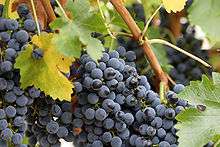Glaucous
| Glaucous | |
|---|---|
| Hex triplet | #6082B6 |
| sRGBB (r, g, b) | (96, 130, 182) |
| CMYKH (c, m, y, k) | (47, 29, 0, 29) |
| HSV (h, s, v) | (216°, 47%, 71%) |
| Source | ISCC-NBS |
|
B: Normalized to [0–255] (byte) H: Normalized to [0–100] (hundred) | |
Glaucous (from the Latin glaucus, meaning "bluish-grey or green", from the Greek glaukós) is used to describe the pale grey or bluish-green appearance of the surfaces of some plants, as well as in the names of birds, such as the glaucous gull (Larus hyperboreus), glaucous-winged gull (Larus glaucescens), glaucous macaw (Anodorhynchus glaucus), and glaucous tanager (Thraupis glaucocolpa).
The term glaucous is also used botanically as an adjective to mean "covered with a greyish, bluish, or whitish waxy coating or bloom that is easily rubbed off" (e.g. glaucous leaves).
The first recorded use of glaucous as a color name in English was in the year 1671.[1]
Examples
The epicuticular wax coating on mature plum fruit gives them a glaucous appearance. Another familiar example is found in the common grape genus (Vitis vinifera). Some cacti have a glaucous coating on their stem(s). Glaucous coatings are hydrophobic so as to prevent wetting by rain. Their waxy character serves to hinder climbing of leaves, stem or fruit by insects. On fruits, glaucous coatings may function as a deterrent to climbing and feeding by small insects in favor of increased seed dispersal offered by larger animals such as mammals and birds.
The blue-grey camouflage coloring of some species of birds and sea and land animals causes their appearance to blend with their surroundings, making their detection by predators or prey difficult.
 Wine grapes with glaucous coating
Wine grapes with glaucous coating Plums with some glaucous coating visible
Plums with some glaucous coating visible- Sedum spathulifolium is a glaucous perennial herbaceous plant.
_(13667579863).jpg) Larus hyperboreus (glaucous gull)
Larus hyperboreus (glaucous gull) Blue shark (Prionace glauca)
Blue shark (Prionace glauca)
See also
References
- ↑ "Glaucous, a.". Oxford English Dictionary. 2010.
External links
| Wikimedia Commons has media related to Glaucous leaves. |
 The dictionary definition of glaucous at Wiktionary
The dictionary definition of glaucous at Wiktionary